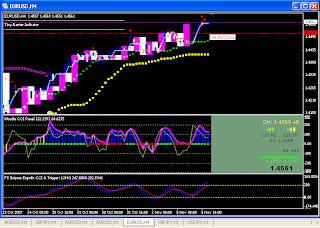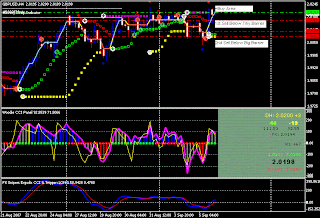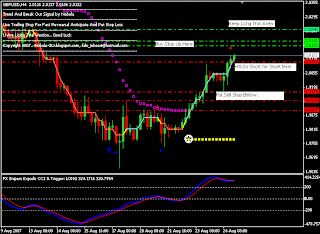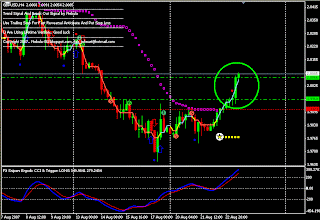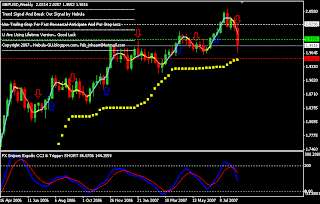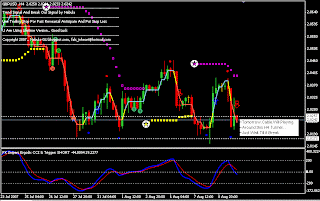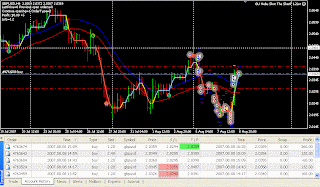By Alexis Xydias
Aug. 11 (Bloomberg) -- European stocks declined for a fourth week, extending a global rout that has wiped out about $2.7 trillion in market value, on concern that a widening credit crunch may hurt economic growth and erode earnings.
HBOS Plc, the U.K.'s largest mortgage provider, and Dutch lender ABN Amro Holding NV led the decline. Antofagasta Plc and Boliden AB paced mining shares lower as metal prices tumbled.
The Dow Jones Stoxx 600 Index dropped 2.5 percent to 362.77, a five-month low. The measure has fallen 9.4 percent since reaching a 6 1/2-year high on June 1. The Stoxx 50 sank 2.4 percent, while the Euro Stoxx 50, a measure for the euro region, lost 1.6 percent.
Shares in banks, brokerages and money managers tumbled worldwide amid signs that the debacle in the U.S. mortgage market is spreading. BNP Paribas SA, France's biggest bank, halted withdrawals from funds and the U.S. Federal Reserve, the European Central Bank and Bank of Japan pumped cash into the banking system, aiming to stem a collapse in credit markets.
``It's a bit of a can of worms that has been opened,'' said Toby Nangle, who helps manage $37 billion in assets at Baring Asset Management in London. ``We are not quite sure where it will end. We might see a major economic impact.''
National benchmarks fell in all 18 western European benchmarks. The U.K.'s FTSE 100 dropped 3 percent, France's CAC 40 sank 2.7 percent and Germany's DAX decreased 1.2 percent.
``Everyone is very afraid,'' said Jacques Porta, who helps manage $180 million at Ofivalmo Patrimoine in Paris. ``There's lack of confidence on the financial sector. I am selling banks.''
HBOS, Man Group
HBOS slid 8.4 percent to 873 pence. Man Group Plc, the world's largest publicly traded hedge fund company, tumbled 12 percent to 479.25 pence. Dexia SA, the owner of U.S. bond insurer Financial Security Assurance Inc., fell 4 percent to 19.16 euros.
Deutsche Bank AG dropped 3.3 percent to 95.19 euros. Germany's biggest bank said the assets in one of its investment funds have fallen by 30 percent since the end of July as subprime mortgage losses roiled credit markets.
The European Central Bank loaned 156 billion euros ($213 billion). The Fed added $38 billion in temporary reserves and the Bank of Japan added 1 trillion yen ($8.5 billion) to the financial system.
BNP, ABN Amro
BNP Paribas dropped 1.9 percent to 78.97 euros. France's biggest bank said it halted withdrawals from three investment funds because it couldn't ``fairly'' value their holdings after subprime mortgage losses rattled debt markets.
ABN Amro, the target in the world's biggest banking takeover, lost 3.4 percent to 33.85 euros on speculation bids by Barclays Plc or a group led by Royal Bank of Scotland Group Plc may falter.
Recent market turmoil ``does jeopardize the ABN Amro deal,'' said Mike Trippitt, a London-based analyst at Oriel Securities Ltd. who has a ``buy'' rating on Barclays and Royal Bank stock. ``If you believe the market, the current share prices are telling you the deal isn't going to happen.''
Jochem van de Laarschot, a spokesman for Amsterdam-based ABN Amro, said there are ``no new developments in the offer process.'' Royal Bank Chairman Tom McKillop said the market turmoil won't derail the deal.
Antofagasta, the owner of three copper mines in Chile, slid 9.9 percent to 620 pence this week. Boliden, Scandinavia's sole copper producer, fell 7.1 percent to 139.75 kronor.
Copper prices in London dropped 3 percent in the week. Nickel plummeted 9 percent. Zinc and aluminum also fell.
Petroplus, Nokian Renkaat
Petroplus Holdings AG plunged 15 percent to 104.3 Swiss francs even after the Swiss refiner posted a second-quarter profit. Earnings were limited by maintenance work at the Cressier refinery and the BRC refinery, the company said.
Nokian Renkaat Oyj jumped 5.8 percent to 24.33 euros. The biggest Nordic tiremaker said that second-quarter profit rose 69 percent, beating analyst estimates, after it raised prices.
Rentokil Initial Plc increased 7.5 percent to 165 pence. Merrill Lynch & Co. raised its recommendation on the world's biggest pest-control company to ``buy'' from ``neutral.''
``After 3 1/2 years of declining profits, we believe Rentokil's profits momentum is at an inflection point,'' a team of analysts led by Andrew Ripper said.
To contact the reporters on this story: Alexis Xydias in London at axydias@bloomberg.net










